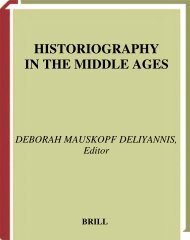Medieval Sexuality: A Casebook - Julian Emperor
Medieval Sexuality: A Casebook - Julian Emperor
Medieval Sexuality: A Casebook - Julian Emperor
Create successful ePaper yourself
Turn your PDF publications into a flip-book with our unique Google optimized e-Paper software.
<strong>Sexuality</strong> in Late Lombard Italy 911112342225672228910111232224567892022212345678930111123435678940111123222and plausible interpretation. This is important because studies of specific earlymedieval societies at given moments in their histories can help to clarify howhuman cultures transmit ideas about sexuality from one generation to the next,from adults to children, from teachers to pupils and so on. Also, we can think alittle about how such ideas circulated within this society as a counterweight tothe emphasis often placed in the history of sexuality on “major” figures—suchas Augustine or Freud: history is not just about the creation of ideas but abouttheir acceptance or lack of acceptance by others too. 10The last preliminary point before looking at the evidence is, of course, thethorny matter of definitions of “sexuality.” One of the reasons why many historiansof sexuality devote little attention to pre-modern periods is that they believe thatthese were times “before sexuality” (to quote the famous phrase of the classicistDavid Halperin). 11 There is little doubt that, in many senses, this view is correct.A self-conscious sexual “identity,” thought to be an essential and fundamentalpart of every human being, is a modern idea that emerged at the end of the nineteenthcentury from a curious mélange of sexology and psychoanalysis. 12 Fromthis viewpoint, “homosexuality” cannot be attributed to medieval societies (nor,in the strict sense, can heterosexuality be so attributed, although this has oftenbeen done without thinking by many historians). However, sexuality can be usedin a different way to describe, as Karras puts it, “the whole realm of human eroticexperience” and “the meanings of sex for people who did not identify themselveswith particular sexualities as we now understand them.” 13 It is this wide-rangingsense that I adopt here when I use the word “sexuality”. Early medieval people,as we shall see, did write about sex, and it is illuminating to pay close attentionto the words and phrases they used when they did so for it is only by doing thisthat we can grasp what made them both similar to and different from us and also,perhaps, re-think current understandings of the history of sexuality as a field. 14Definitions of sexuality are made more complex by the ways in which earlymedieval people dealt with gender. For example, as far as I am aware no statementmade by a Lombard woman about sexuality has survived. Our view of Lombardfemale sexuality has, therefore, to be mediated through male opinion, which ishardly ever sympathetic to women in this period. 15 But when women’s views onsex can be uncovered directly—perhaps in reading the works of the CarolingianDhuoda or the Ottonian Hrotswitha—they are often found to be subtly subversiveof established, male, norms. 16 Most studies of gender within Lombard society,including those by Cristina La Rocca, Brigitte Pohl-Resl, Trish Skinner, WalterPohl and myself, have revealed a society in which women were far from equalwith men. 17 This does not mean, necessarily, that women could not take controlover aspects of their lives, and, indeed, taking control of their sexual lives mayhave been one such area in which they could do so, as some scholars havesuggested with regard to contraception, for example. 18 Julia Smith, among others,has argued that women could have a surprising amount of space to be creativeand influential, especially within the sphere of family life. However, because













